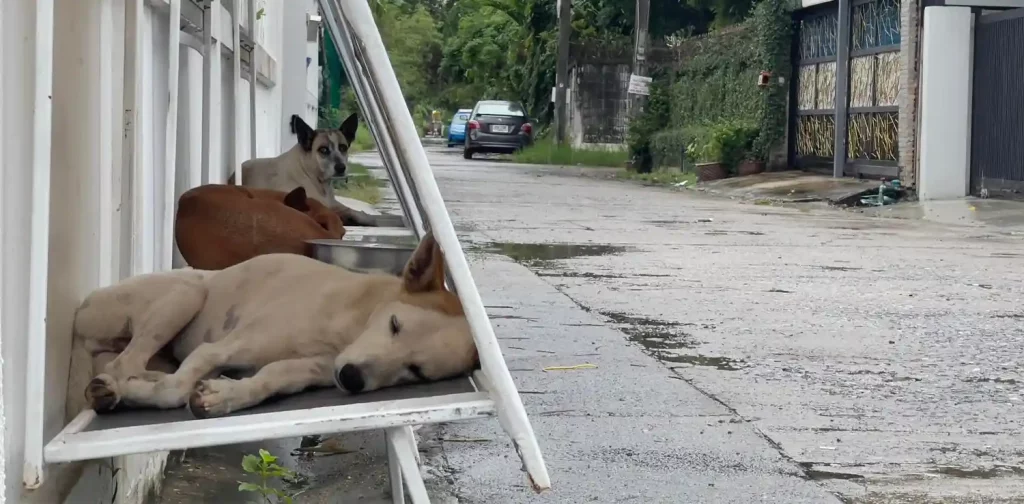Shelters for Thailand Stray Dogs

Photo by Yodsa Gap on Facebook
There are thousands of stray dogs living on the streets of Thailand. While randomly bumping into dogs might be a cute little surprise for us, it’s not as pleasant for the dogs living on the road. Most of them are abandoned, and they depend on the passersby and locals to feed and give them shelter.
Tackling this stray dog overpopulation problem is not easy. It covers various aspects such as food, health, shelter, and city cleanliness. Recently, Stand for Strays started a project to provide shelters for stray dogs.
Foldable and sustainable shelters
Ajarn Yossaphon Chanthongjeen designed the shelters by recycling used billboards with the simple goal of protecting stray dogs from the heat and rain. They are attached to walls around Wat Nang Nong in Bangkok’s Chom Thong district and Muang Thong Thani in Nonthaburi’s Pak Kret district, where the project was initiated.
The shape is similar to a half-tent. It is foldable, with a flat surface propped with steel for the dogs to lie down on. Instructions are illustrated on the covers so that everyone can use them in case there are dogs in need. It’s also equipped with bowls for food and drink.
Tackling stray dogs overpopulation
In 2016, the number of stray dogs in Thailand reached 730,000. Many people abandon their grown dogs due to expensive costs. The lack of efforts in sterilizing these strays also contributes to the booming number.
Unvaccinated dogs without proper care are vulnerable to rabies. The 2018 rabies outbreak in Thailand discovered that dogs are the primary carrier of the disease. Along with building shelters, Stand for Strays also employs volunteers to take care of stray dogs. This care includes sterilizing, vaccinating, feeding, and cleaning stray dogs to prevent rabies outbreaks.
To address the pet abandonment issue and tackle the roots of overpopulation, Thailand’s government started requiring pet owners to register their pets in 2018 with the cost of 450 baht per animal. Owners who fail to register their pets would be fined up to 25,000 baht.
At the beginning of the announcement, the law raised some concerns regarding the cost burden. Furthermore, communities believe that taking care of the existing stray dogs through vaccination and sterilization should be a part of the ultimate solution.
Animals in sustainable development
Animals are a part of our biodiversity, and animal welfare is important in sustainable development. In our pursuit of a better future, animals must not be left behind. Efforts such as wildlife conservation, regulating the use of animals in tourism, and ecosystem conservation must continue.

Join Green Network Asia Membership
If you find this content useful, support Green Network Asia’s movement to create positive impact for people and the planet through public education and multi-stakeholder advocacy on sustainability-related issues and sustainable development. Get exclusive benefits for personal and professional development.
Become a Member Now
Kresentia Madina
Madina is the Assistant Manager for Digital Publications at Green Network Asia. She graduated from Universitas Indonesia with a bachelor's degree in English Literature. She has three years of professional experience working on GNA international digital publications, programs, and partnerships particularly on social and cultural issues.


 Strengthening Societal Resilience in the Age of Disruptions
Strengthening Societal Resilience in the Age of Disruptions  Building Strategic Approach to Support Urban Health for All
Building Strategic Approach to Support Urban Health for All  Understanding and Addressing Multiple Dimensions of Child Deprivation
Understanding and Addressing Multiple Dimensions of Child Deprivation  Building Heat Resilience Amidst Rising Risk in the Asia-Pacific
Building Heat Resilience Amidst Rising Risk in the Asia-Pacific  Sounds Right and Recognizing Nature as an Artist for Biodiversity Conservation
Sounds Right and Recognizing Nature as an Artist for Biodiversity Conservation  Statewide Treaty Bill: Australia’s First Treaty with the Indigenous Australians Passed in Victoria
Statewide Treaty Bill: Australia’s First Treaty with the Indigenous Australians Passed in Victoria